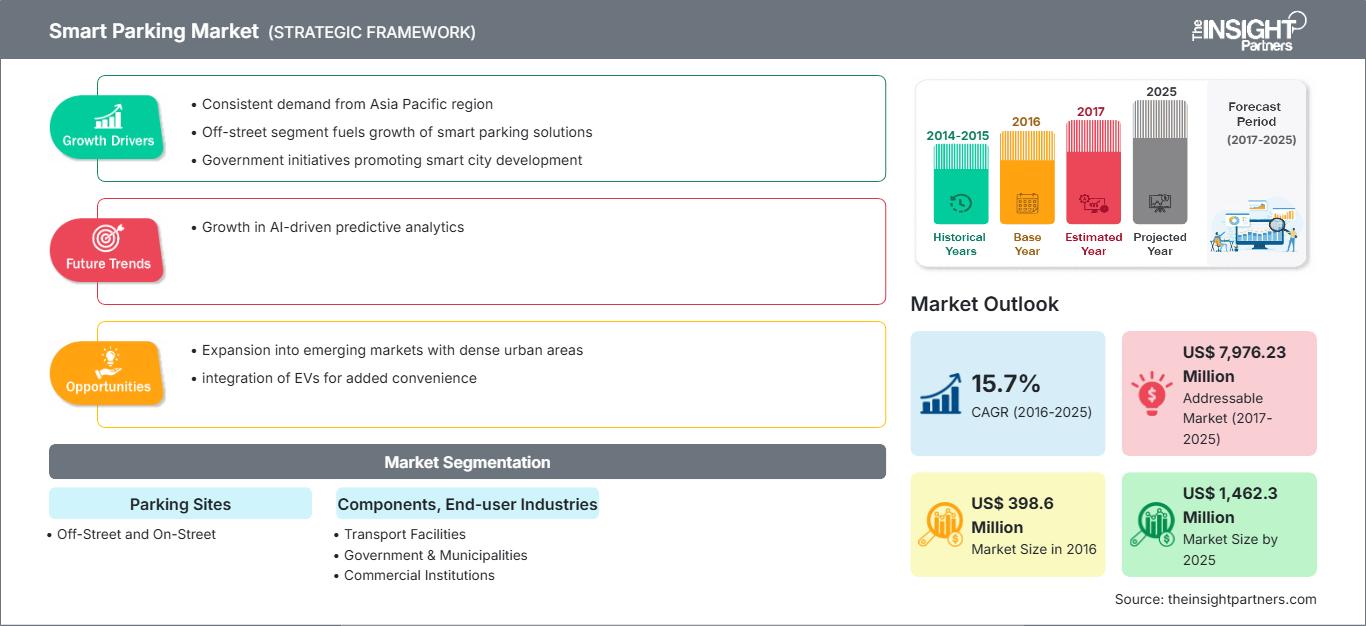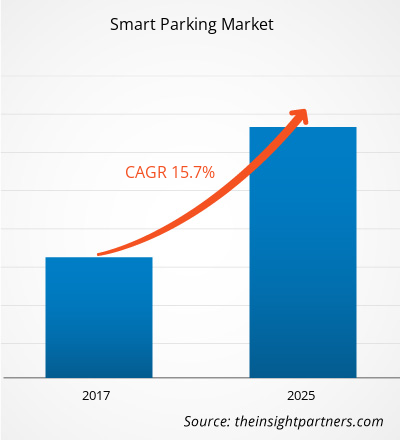Se espera que el mercado de estacionamiento inteligente crezca de US$ 398,6 millones en 2016 a US$ 1.462,3 millones en 2025 a una CAGR del 15,7% entre 2017 y 2025.
Los sistemas de estacionamiento inteligente abordan problemas críticos de estacionamiento, facilitando a los conductores el estacionamiento de sus vehículos sin perder tiempo ni combustible. Ofrecen a sus usuarios información en tiempo real sobre las plazas de aparcamiento disponibles en la ciudad, reduciendo así la congestión vehicular causada por la mala gestión de las plazas. Amano Mcgann, Smart Parking Ltd., Xerox, Cisco y Urbiotica se encuentran entre los principales actores que operan en este mercado. Norteamérica, al ser una región tecnológicamente avanzada con una gran densidad de vehículos y congestión vehicular en las ciudades, ha sido testigo del mayor índice de adopción de sistemas de estacionamiento inteligente por parte de gobiernos y municipios de diversas ciudades. Europa es el segundo mayor país en adopción de sistemas de estacionamiento inteligente, mientras que se prevé que la región APAC, con una creciente urbanización y tendencias tecnológicas en alza, sea la de mayor crecimiento a nivel mundial en el mercado del estacionamiento inteligente.
Perspectivas del mercado
El mercado de estacionamiento inteligente se impulsa gracias al continuo crecimiento de la demanda en Asia Pacífico
Actualmente, los sistemas de estacionamiento inteligente han experimentado una adopción significativa en América del Norte y Europa. Además, gracias a los avances tecnológicos e infraestructura, se espera que diversas economías en desarrollo de Asia Pacífico y Oriente Medio y África, como el gran proyecto en la ciudad de Wellington, experimenten una adopción significativa de soluciones de estacionamiento inteligente en proyectos piloto en Canberra, Singapur, Tailandia, Dubái y Arabia Saudita. Si bien América del Norte y Europa dominan el mercado global de estacionamiento inteligente, se prevé que cedan su cuota de ingresos a Asia Pacífico durante el período de pronóstico. Por otro lado, se espera que Asia Pacífico registre una tasa de crecimiento del 18,9 % entre 2016 y 2025 en el mercado global de estacionamiento inteligente.
Obtendrá personalización en cualquier informe, sin cargo, incluidas partes de este informe o análisis a nivel de país, paquete de datos de Excel, así como también grandes ofertas y descuentos para empresas emergentes y universidades.
Mercado de estacionamiento inteligente: perspectivas estratégicas

- Obtenga las principales tendencias clave del mercado de este informe.Esta muestra GRATUITA incluirá análisis de datos, desde tendencias del mercado hasta estimaciones y pronósticos.
El mercado global de estacionamiento inteligente está impulsado por el segmento de estacionamiento fuera de la calle
Avances tecnológicos como el uso de aplicaciones móviles para sistemas de guía de estacionamiento, soluciones mejoradas de emisión de tickets y pagos, y un crecimiento significativo en la adopción de sistemas de estacionamiento inteligente por parte de instituciones comerciales y corporativas son factores que se espera impulsen la demanda del mercado de sistemas de gestión de estacionamiento fuera de la vía pública. Este tipo de estacionamiento beneficia tanto a los usuarios de corto como de largo plazo. Sin embargo, se espera que el alto costo inicial de implementación de los sistemas de estacionamiento fuera de la vía pública limite el crecimiento del mercado. El segmento de estacionamiento fuera de la vía pública lidera actualmente el mercado global de estacionamiento inteligente y se espera que mantenga su dominio durante el período de pronóstico.
La iniciativa de mercado se consideró la estrategia más adoptada en el mercado global de estacionamiento inteligente. A continuación, se enumeran algunas de las estrategias recientes de algunos actores del mercado de estacionamiento inteligente.
- 2017: Amano Mcgann extendió su asociación con uno de sus distribuidores más antiguos, PSX, a Colorado.
- 2017: Valeo y Cisco anunciaron un acuerdo de cooperación para desarrollar innovaciones estratégicas en servicios de movilidad inteligente.
- 2017: Smart Parking anunció que ganó un nuevo contrato en Nueva Zelanda, elegido por Wilson Parking New Zealand como el proveedor preferido de sensores y tecnología de localización de plazas en nueve nuevos sitios.
- 2017: Smart Parking lanzó su nuevo diseño SmartSpot IoT Gateway, con características nuevas y mejoradas adaptadas para satisfacer las necesidades de las ciudades inteligentes.
Perspectivas regionales del mercado de estacionamiento inteligente
Los analistas de The Insight Partners han explicado detalladamente las tendencias regionales y los factores que influyen en el mercado del estacionamiento inteligente durante el período de pronóstico. Esta sección también analiza los segmentos y la geografía del mercado del estacionamiento inteligente en Norteamérica, Europa, Asia Pacífico, Oriente Medio y África, y Sudamérica y Centroamérica.
Alcance del informe del mercado de estacionamiento inteligente
| Atributo del informe | Detalles |
|---|---|
| Tamaño del mercado en 2016 | US$ 398,6 millones |
| Tamaño del mercado en 2025 | US$ 1.462,3 millones |
| CAGR global (2016-2025) | 15,7% |
| Datos históricos | 2014-2015 |
| Período de pronóstico | 2017-2025 |
| Segmentos cubiertos | Por lugares de estacionamiento
|
| Regiones y países cubiertos | América del norte
|
| Líderes del mercado y perfiles de empresas clave |
|
Densidad de actores del mercado de estacionamiento inteligente: comprensión de su impacto en la dinámica empresarial
El mercado del estacionamiento inteligente está creciendo rápidamente, impulsado por la creciente demanda del usuario final debido a factores como la evolución de las preferencias de los consumidores, los avances tecnológicos y un mayor conocimiento de los beneficios del producto. A medida que aumenta la demanda, las empresas amplían su oferta, innovan para satisfacer las necesidades de los consumidores y aprovechan las tendencias emergentes, lo que impulsa aún más el crecimiento del mercado.

- Obtenga una descripción general de los principales actores clave del mercado de estacionamiento inteligente
Sistemas globales de estacionamiento inteligente: Segmentación del mercado
Por lugar de estacionamiento
- Estacionamiento fuera de la calle
- Estacionamiento en la calle
Por componentes
- Hardware
- Software
- Servicio
Por industria de usuario final
- Instalaciones de transporte
- Gobiernos y Municipios
- Instituciones comerciales
- Instituciones corporativas
Por geografía
- América del norte
- A NOSOTROS
- Canadá
- México
- Europa
- Francia
- Alemania
- Italia
- España
- Reino Unido
- Resto de Europa
- Asia Pacífico (APAC)
- Japón
- Porcelana
- India
- Australia
- Resto de APAC
- Oriente Medio y África (MEA)
- Arabia Saudita
- Emiratos Árabes Unidos
- Sudáfrica
- Resto de MEA
- América del Sur (SAM)
- Brasil
- Resto de SAM
Perfiles de empresas
- Cisco Systems, Inc.
- Amano McGann, Inc.
- Estacionamiento inteligente Ltd.
- Urbiótica
- Skidata AG
- Swarco AG
- Parkmobile, LLC
- Nedap NV
- Kapsch
- Corporación Xerox.
- Parkmobile, LLC
- SWARCO AG
- Análisis histórico (2 años), año base, pronóstico (7 años) con CAGR
- Análisis PEST y FODA
- Tamaño del mercado, valor/volumen: global, regional y nacional
- Industria y panorama competitivo
- Conjunto de datos de Excel
Informes recientes
Testimonios
Razón para comprar
- Toma de decisiones informada
- Comprensión de la dinámica del mercado
- Análisis competitivo
- Información sobre clientes
- Pronósticos del mercado
- Mitigación de riesgos
- Planificación estratégica
- Justificación de la inversión
- Identificación de mercados emergentes
- Mejora de las estrategias de marketing
- Impulso de la eficiencia operativa
- Alineación con las tendencias regulatorias




















 Obtenga una muestra gratuita para - Mercado de estacionamiento inteligente
Obtenga una muestra gratuita para - Mercado de estacionamiento inteligente